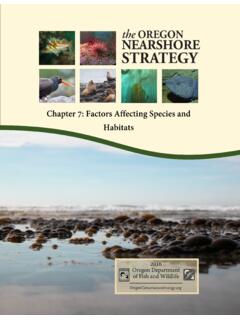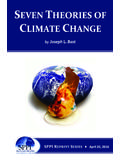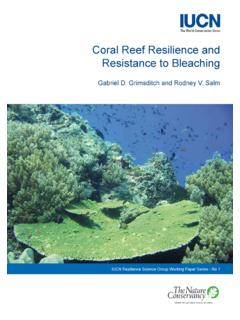Transcription of OREGON CONSERVATION STRATEGY
1 The OREGON . CONSERVATION . STRATEGY . FACT SHEET. Climate Change and OREGON 's Nearshore Open Water Habitat OREGON Department of Fish and Wildlife O regon's nearshore open water, or pelagic habitats, include the waters that overlay subtidal areas between the extreme low tide and the 30 fathom (180 feet or 55 meter) depth contour1. These waters are part of what is called the neritic zone, which extends out to a depth of approximately 650 feet (200 m). Open water habitats are affected by light, water temperature, stratification of water, physical mixing, and surface and underwater currents1. Seawater properties in nearshore habitats are affected by freshwater inputs, local environmental forcing, and large-scale conditions across the Pacific Ocean, including the offshore California Current System. Open water habitats support many species of fish, mammals, seabirds, invertebrates, and algae; all of which are interconnected through physical, chemical, biological, geological, and human use factors.
2 Open water habitats are very important to the ecology of the nearshore ocean. This is where plankton, free- floating organisms that provide food for many marine organisms, live1. Phytoplankton, microscopic plant-like organisms, are the primary producers that transform sunlight, carbon dioxide, and nutrients into oxygen and the food that form the base of the marine food web. Zooplankton, the next link in the marine food web, are planktonic animals that range in size from microscopic to several meters in diameter1. Zooplankton include species that live their entire lives drifting with the currents, but also many fish and invertebrates that start their lives as larvae before growing to adults. Nekton, or strong swimmers, typical in open water habitats include schooling and highly migratory species such as squid, fish, sharks, and marine mammals1.
3 Open water habitats and their associated biological communities provide many benefits, including: primary production of biomass supporting the marine food web;. daily, seasonal, annual, and decadal cycling of nutrients and gases;. abundant food sources that satisfy recreational, commercial, and cultural values; and economic opportunities for coastal communities through fishing, tourism, energy development and shipping. Human uses of nearshore open water habitats primarily include fishing, recreational boating, and shipping. Changes in freshwater input patterns from hydropower regulation in larger rivers also affect open water habitats. Fishing pressure, oil spills, noise pollution, introduction of non-native species, and changes to freshwater inputs are among the factors identified to be of greatest concern to managers1.
4 The rise of atmospheric carbon dioxide will bring new threats and may exacerbate existing impacts to OREGON 's nearshore open water species and habitats. Consequences of Increased Carbon food supply, decreased reproductive success, changes in Dioxide for OREGON 's Open Water Areas distribution, habitat alteration, or other effects. Rising atmospheric carbon dioxide is causing a variety of Changes in Oceanic Cycles impacts on the marine environment, including altered OREGON 's nearshore ocean is constantly changing, ocean circulation, warming sea temperatures, changing making it challenging to sort out signals of climate weather patterns, and changes to freshwater runoff and change impacts from other environmental cycles. ocean chemistry2. As open water habitats change, The relationship between each of these cycles and individual fish and wildlife species will respond in rising carbon dioxide levels is not well understood.
5 Different ways to these environmental changes. As a Understanding how oceanic cycles function is a result, open water species may experience diminished Cover Photos: Northern anchovy school. Photo by Geoff Shester, Oceana, Photo. Sea nettle. ODFW Photo. Gray whales. NOAA photo. 1 OREGON Department of Fish and Wildlife necessary first step to understanding how climate diversity6,7. During upwelling conditions, zooplankton change may alter the nearshore environment. populations are higher but species diversity tends to be lower than during winter downwelling conditions8. Climate change may alter the patterns of seasonal Along with upwelled water, plankton is carried from upwelling and downwelling that make up the annual the highly productive continental shelf and broadly cycle (Figure 1). Upwelling is the wind-driven circulation distributed by the California Current System9.
6 Of cold, nutrient-rich water from deep in the ocean up to nearshore waters in the spring and summer. When the delivery of nutrient-rich bottom water is Downwelling is the movement of warmer, oxygen-rich delayed, primary production of marine algae and surface water from the nearshore to deeper waters phytoplankton are also postponed5. Transport of during fall and winter. As the climate warms, the planktonic fish and invertebrate larvae in circulating alongshore winds that drive this cycle may grow waters may not occur in time for successful stronger, therefore intensifying upwelling3. As a replenishment of coastal populations5. Many consequence of climate change, predictions suggest migratory species, such as whiting, sardine, and that the spring transition from downwelling to humpback whales, time movement to maximize upwelling conditions will be delayed and followed by exposure to productive waters to benefit feeding, stronger upwelling effects later in the season4,5.
7 Spawning or breeding requirements10. Marine species will likely need to make adjustments to regular Both upwelling and downwelling are important to timing of life activities and may respond by moving maintaining the base of the marine food web, and north or towards shore10,11. Many nearshore marine this dynamic may become out of balance as ocean fish, including rockfishes, salmon, and sardine, require conditions become less predictable. The timing and strong upwelling for high offspring survival10,11. strength of winds affecting upwelling play a major role in determining annual productivity and species (a.) Summer 1A. Spring and Summer Figure 1. Upwelling and Downwelling 1A. During spring and summer, winds from the north blow parallel to the shore, exerting drag on the ocean's surface. The combination of energy transfer downward in the water column and the earth's rotation move surface in g e ll waters off shore, 90 degrees to the right of pw the wind direction.
8 This water is replaced by U. ZOOPLANKTON. cold, nutrient rich, low oxygen waters from PHYTOPLANKTON. the deep offshore ocean. This process is called upwelling. During spring/summer upwelling production of nearshore plants and animals is at its highest. (b.)and 1B. Fall Winter Winter 1B. During fall and winter, winds from the south blow parallel to the shore driving surface waters shoreward where they submerge in a process called downwelling. Downwelling transports nearshore surface ng waters to resupply deep offshore waters with lli e oxygen. Storm activity is highest, and runoff w wn from precipitation over land contributes to Do ZOOPLANKTON. mixing nearshore waters and loading the PHYTOPLANKTON. environment with oxygen and freshwater inputs OREGON Department of Fish and Wildlife 2. In addition to annual cycles, interannual (multi-year) overlap in distribution may alter nearshore community cycles such as atypical conditions from the El Ni o dynamics.
9 Some fish species exhibit enhanced growth Southern Oscillation (ENSO) also cause physical changes and survival when cool water zooplankton are available in open water habitats13. During the ENSO cycle, water because this food base provides greater biomass and temperatures alternate between warmer El Ni o and higher energy content6. The abundance, distribution, cooler La Ni a conditions. The cycle typically occurs and spawning success of Pacific sardine are strongly over a period of three to seven years with warm or influenced by sea surface temperature22. Jellyfish cold conditions persisting for six to twelve months at abundance can change dramatically from year to year a time12,13. El Ni o events have intensified in recent based on fluctuations in sea surface temperature23. decades and may become more intense and more Jellyfish can quickly replace fish as dominant species frequent in coming years14-17.
10 If populations are subjected to major environmental change24. El Ni o events can affect upwelling, water circulation, and temperatures13. In turn, this affects primary productivity, species distribution and abundance, and marine food web dynamics in OREGON 's nearshore13. Severe El Ni o events reduce planktonic food-sources, redistribute algae to greater depth, and decimate localized populations of kelp, fish, or invertebrates13,15. Strong El Ni o conditions from 1983 resulted in low overall plankton productivity and an influx of southern species in OREGON , which dramatically affected food web dynamics18. Warming Ocean Temperatures The world's oceans are warming. For most of the past century, significant changes in sea surface temperature have been recorded in the northeast Pacific13 as most of the heat added to the atmosphere is absorbed by the ocean19.









